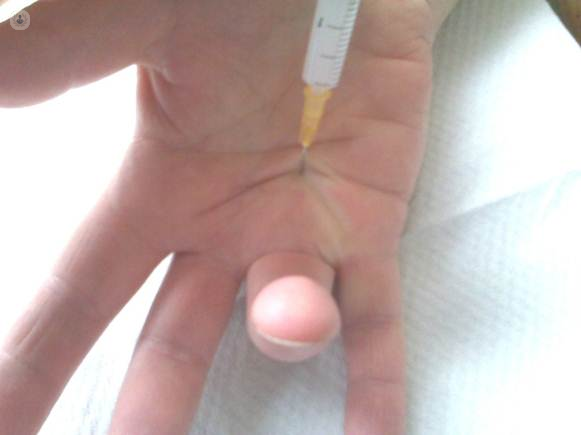Treatment for trigger finger
Written by:Trigger finger is an awkward condition where the digit gets stuck in a bent position and it is difficult to straighten. As time goes on, the condition only gets worse, unless you get treatment. How do doctors deal with this condition? Leading orthopaedic surgeon Mr James Nicholl is here to provide answers on trigger finger treatment.

Steroid injections
The first line of treatment is a steroid injection into the palm of the hand. This permanently settles the condition in up to 75% of patients.
In the remaining cases, where the injection is not successful, it is increasingly unlikely that further injections will have the desired effects. Patients who do not respond to the injection will generally go on to need surgery.

Trigger finger surgery
Trigger finger surgery aims to open up the tight collar snagging the tendon. We don’t cut out the nodule itself because that would weaken the tendon.
Surgery has a 95% cure rate and carries minimal risk. It is usually performed as a day case. The area is numbed with local anaesthetic and a tourniquet is inflated around the upper arm to keep blood out of the hand. A transverse cut of approximately 1 cm is made at the base of the affected digit. The mouth of the tunnel through which the tendon passes is cut to open up the tight collar. The tourniquet is released and any bleeding is controlled. The incision is closed with fine stitches and a dressing is applied.
The patient may be given painkillers to take for a few days after surgery. The dressing is removed after a couple of days, but the wound should be kept covered (for example by an Airstrip) and dry until the stitches are removed two weeks later. It is important to keep the fingers moving and avoid pressure on the incision.
Risks of trigger finger surgery
As with any operation, there are small risks, but thankfully the following are uncommon:
- Tenderness of the scar
- Stiffness of the digit
- Nerve injuries – these are the most serious complication, but are fortunately very rare. They can cause loss of feeling in the fingertip.
- Infection
- Very occasionally the surgery doesn’t successful relieve the symptoms.
Unfortunately, patients who have trigger finger in one digit are prone to having it in others too, and may need treatment to release the tendons in these fingers too.



